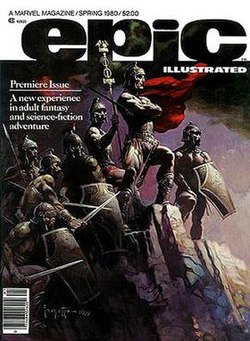Epic Illustrated
| Epic Illustrated | |
|---|---|

Epic Illustrated #1 (Spring 1980).
Cover painting by Frank Frazetta |
|
| Publication information | |
| Publisher | Marvel Comics/Epic Comics |
| Format | Ongoing series |
| Publication date(s) | Spring 1980–February 1986 |
| No. of issues | 34 |
| Editor(s) | Archie Goodwin |
Epic Illustrated was a comics anthology in magazine format published in the United States by Marvel Comics. Similar to the US-licensed comic book magazine Heavy Metal, it allowed explicit content to be featured, unlike the traditional American comic books of that time bound by the restrictive Comics Code Authority, as well as offering its writers and artists ownership rights and royalties in place of the industry-standard work for hire contracts. The series lasted for 34 issues from Spring 1980–February 1986.
A color comic-book imprint, Epic Comics, was spun off in 1982.
The magazine was initiated under editor Rick Marschall in 1979 under the title Odyssey, and originally set to launch as an issue of Marvel Super Special. After Marschall learned of at least seven other magazines titled Odyssey, the project was renamed Epic Illustrated and launched as a standalone series. Marschall was replaced by editor Archie Goodwin in September 1979, several months before the first issue was published.
The anthology featured heroic fiction and genre stories, primarily fantasy and science fiction, but in a broad range of styles. Established mainstream-comics talents such as John Buscema, Jim Starlin, John Byrne, and Terry Austin were featured, as well as independent-press creators as Wendy Pini and The Studio's Jeffrey Jones, Michael Kaluta, Barry Windsor-Smith, and Bernie Wrightson. Goodwin commissioned stories by many new artists, including Stephen R. Bissette, Pepe Moreno, Jon J Muth, Rick Veitch and Kent Williams. The full-color magazine format, allowed for a broader range of color than the traditional three-color printing process, and many of the stories, and all the covers, were painted. Fantasy artists who did not normally work in the comics field, such as Richard Corben, Frank Frazetta, The Brothers Hildebrandt, and Boris Vallejo contributed covers. The contributors to the series retained ownership of their material and were paid royalties.
...
Wikipedia
